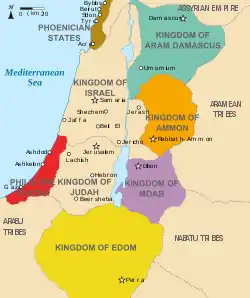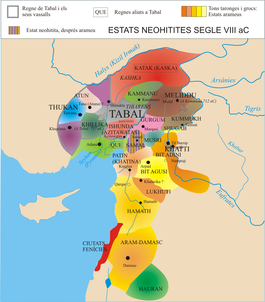Aram-Damascus
Aram-Damascus (/ˈɛrəm/ or /ˈærəm dəˈmæskəs/) was an Aramean state around Damascus in Syria,[1] from the late 12th century BC to 732 BC.
Kingdom of Aram-Damascus | |
|---|---|
| Late 12th century BC–732 BC | |
 The region around 830 BCE, with Aram-Damascus in green. | |
| Status | Monarchy |
| Capital | Damascus |
| Common languages | Old Aramaic language |
| King | |
• 880 BC – 842 BC | Hadadezer |
• 842 BC – 796 BC | Hazael |
• 754 BC – 732 BC | Rezin (last) |
| History | |
• Established | Late 12th century BC |
• Annexed by the Neo-Assyrian Empire | 732 BC |
Sources for this state come from texts that can be divided into three categories: Assyrian annals, Aramaean texts, and the Hebrew Bible.
The largest portion of the textual sources come from Assyria. There are, however, often several copies of the same texts. Most of the texts are annals from the Assyrian kings Shalmaneser III, Adad-Nirari III, and Tiglath-Pileser III. The texts mention Aram-Damascus (Ša-imērišu, Imērišu, Imirishu) from an Assyrian perspective, but are in many ways informative of the strength of the state, and give us several names of its rulers.
Aramaean royal inscriptions are rare, and only one royal stele from Aram-Damascus proper has been identified — the Tel Dan Stele. Other sources in Aramaic that shed light on the history of Aram-Damascus include two "booty inscriptions" from Eretria and Samos, and the Zakkur stele of the king Zakkur.
The Hebrew Bible gives more detailed accounts of Aram-Damascus' history, mainly in its interaction with Israel. For instance, there are texts of the Bible mentioning David's battles against Aramaeans in southern Syria in the 10th century BC. (2 Samuel 10:6–19) In contrast, the sources for the early history of Aram-Damascus are almost nonexistent. In an annal dating to Tiglath-Pileser I (1114–1076 BC), we learn that Aramaean people have begun settling in the southern half of Syria.
The first reliable data can be found in the 9th century BC when Aramaean, Assyrian, and Hebrew texts all mention a state with its capital in Damascus. The state seems to have reached its peak in the late 9th century BC under Hazael, who, according to Assyrian texts, fought against the Assyrians, and according to Aramaean texts, had some influence over the north Syrian state Unqi,[2] and according to Hebrew texts, conquered all of Israel.(2 Kings 13:3)
To the southwest, Aram-Damascus reached over most of Golan to the Sea of Galilee.[3]
In the 8th century BC, Rezin had been a tributary of Tiglath-Pileser III, the king of Assyria.[4] In c. 732 BC, he allied himself with Pekah, the king of Israel, to attack Ahaz, the king of Judah. However, Ahaz appealed to Tiglath-Pileser III for help. This the Assyrian king obliged, after Judah paid tribute to the Assyrian king. (2 Kings 16:7–9) As a result, Tiglath-Pileser III sacked Damascus and annexed Aram.[4] According to 2 Kings 16:9, the population was deported and Rezin executed. Tiglath-Pileser also records this act in one of his inscriptions.[5]
Aram-Damascus has not yet been identified. Excavations in Damascus are hard to perform, owing to the continuous settlement of the city. Other cities of Aram-Damascus have not been positively identified from textual sources, and excavations of Iron Age sites around Damascus are almost nonexistent. The material culture at sites farther south (e.g. Tell-Ashtara, Tell er-Rumeith, et-Tell, Tel-Dan, Tell el-Oreme ('Oreimeh), to name but a few) do not show many features distinguishing from the material culture of ancient northern Israel.

Kings
| Arameans |
|---|
| Syro-Hittite states |
| Aramean kings |
| Aramean cities |
| Sources |
- Hadadezer 880–842 BC
- Hazael 842–805 or 796 BC
- Ben-Hadad III 796 to 792 BC
- Rezin 754 BC–732 BC
See also
References
- Pitard, Wayne T. (2000). "Arameans". In David Noel Freedman; Allen C. Myers; Astrid B. Beck (eds.). Eerdmans Dictionary of the Bible. Wm. B. Eerdmans Publishing Co. p. 86.
- James B. Pritchard, ed., Ancient Near Eastern Texts Relating to the Old Testament (3rd ed.; Princeton NJ: Princeton University Press, 1955) 246.
- Suzanne Richard (2003). Near Eastern Archaeology: A Reader (Hardcover ed.). Eisenbrauns. p. 377. ISBN 1-57506-083-3.
- Lester L. Grabbe, Ancient Israel: What Do We Know and How Do We Know It? (New York: T&T Clark, 2007): 134
- James B. Pritchard, ed., Ancient Near Eastern Texts Relating to the Old Testament (3rd ed.; Princeton NJ: Princeton University Press, 1969) 283.
Sources
- Amadasi-Guzzo, Maria Giulia (2019). "What Do We Know about the Borders and Exchanges between Aram and Phoenicia in the 9th–8th Centuries B.C.E. in Anatolia and Syria?". Aramaean Borders: Defining Aramaean Territories in the 10th–8th Centuries B.C.E. Leiden-Boston: Brill. pp. 149–171.
- Bagg, Ariel M. (2019). "At the Limits of Historical Geography: Reconstructing Aramaean Territories in the West According to the Neo-Assyrian Written Sources". Aramaean Borders: Defining Aramaean Territories in the 10th–8th Centuries B.C.E. Leiden-Boston: Brill. pp. 1–25.
- Edmonds, Alexander J. (2019). "A People without Borders? Tracing the Shifting Identities and Territorialities of the Ahlameans". Aramaean Borders: Defining Aramaean Territories in the 10th–8th Centuries B.C.E. Leiden-Boston: Brill. pp. 26–62.
- Gzella, Holger (2015). A Cultural History of Aramaic: From the Beginnings to the Advent of Islam. Leiden-Boston: Brill.
- Lipiński, Edward (2000). The Aramaeans: Their Ancient History, Culture, Religion. Leuven: Peeters Publishers.
- Lipiński, Edward (2013). "The Aramaeans in the West (13th–8th centuries)". Arameans, Chaldeans, and Arabs in Babylonia and Palestine in the First Millennium B.C. Wiesbaden: Harrassowitz Verlag. pp. 123–147.
- Lemaire, André (2019). "The Boundary between the Aramaean Kingdom of Damascus and the Kingdom of Israel". Aramaean Borders: Defining Aramaean Territories in the 10th–8th Centuries B.C.E. Leiden-Boston: Brill. pp. 245–266.
- Sader, Hélène (2014). "History". The Aramaeans in Ancient Syria. Leiden: Brill. pp. 11–36.
- Younger, Kenneth Lawson (2016). A Political History of the Arameans: From Their Origins to the End of Their Polities. Atlanta: SBL Press.
- Zwickel, Wolfgang (2019). "Borders between Aram-Damascus and Israel: A Historical Investigation". Aramaean Borders: Defining Aramaean Territories in the 10th–8th Centuries B.C.E. Leiden-Boston: Brill. pp. 267–335.